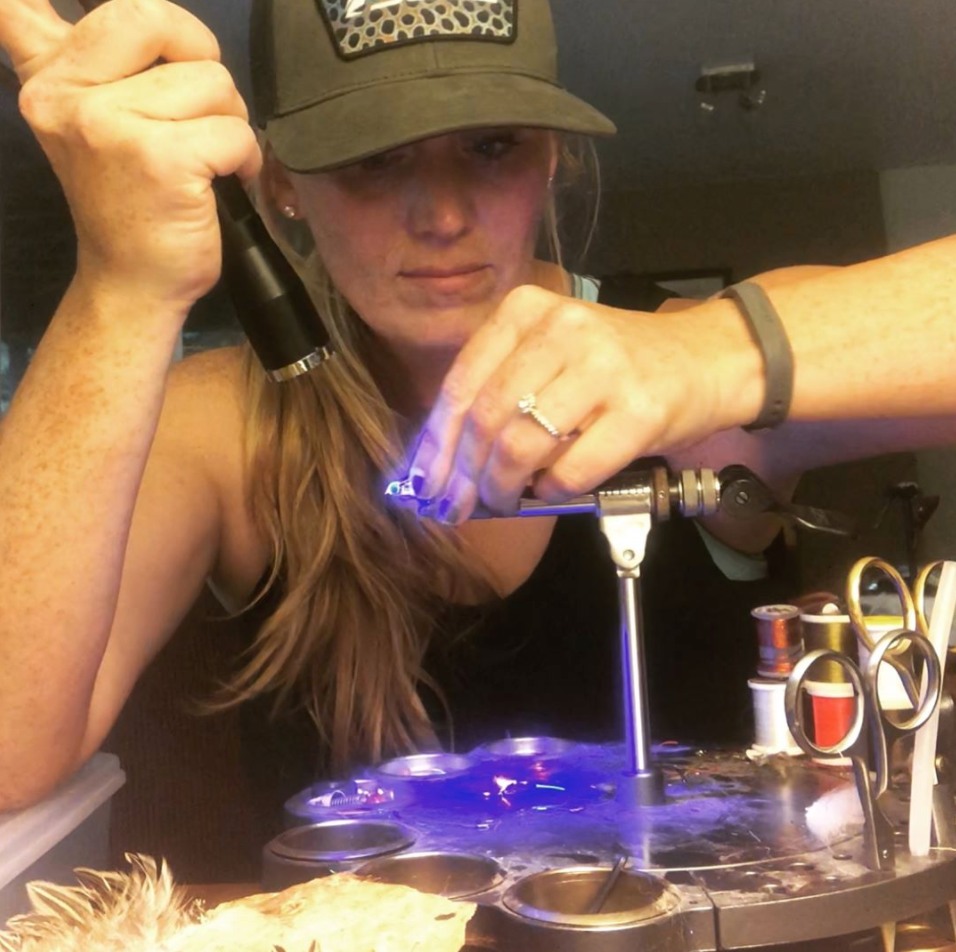Fly Tying: Why Is My Baitfish Pattern Swimming Wrong? Part 2


Do You Ever Have One of Those Days Where You Get Onto the Water, Do Everything “Right,” Have What You Think Is the Perfect Fly, and Still Don't Catch Fish?
I have.
We’ve all been there. I spend hours researching a specific location and designing the best baitfish for it. Then I’ll spend an hour the night before arranging my fly boxes. I pack up all my gear and leave before even the Starbucks opens in hopes of arriving to the location and being first on the water. Once I get there I get everything set up, get the fly tied on, and start fishing. And get absolutely nothing…
Obviously, I can’t help you with casting, weather, or the fact that the McGriddle you ate for breakfast is trying to eat your insides like a tapeworm. But I can help with fly selection. Over the years I have learned a few things about fly design that mean the difference between a fly that fish eat, and a fly they simply look at and turn away.
Below you can learn about a few MORE (see Part 1) of my findings over the years along with video demonstrations in the Fly Tester. Using the Fly Tester helps me observe the swimming action of my flies immediately after tying and improve them so I have confidence they will perform as intended.
1. Don’t Fish a Wet Blanket
Imagine it’s February and you're doing yardwork in Seattle. Following your first adult tantrum due to said yardwork you fall into your pool fully dressed. The obvious result of this would be that you immediately get out, remove wet clothing (in the privacy of your home for good reason), and put on dry gear before heading back out. Now, imagine that instead of doing that, you just run inside and throw additional layers OVER your wet clothes and attempt to continue yardwork. You’d likely feel soggy and heavy within a few minutes.
Now, think of this scenario when you are tying a baitfish that needs a big profile.
The first way most go about doing this is to add more material. This is not the answer, as it turns the fly into a soggy, heavy version of itself that is very tough to cast. Another issue that I’ve found with using too much material is the “jump into a pool with shorts on bubble,” which equates to the excess material in your fly creating a bubble that doesn’t go away for until you pick up to recast. This makes the fly swim weirdly and not sink below the surface film as quickly as it should or as deep as it should.
Fly Tying: Why Is My Baitfish Pattern Swimming Wrong? Part 1
My favorite ways to avoid this is to add materials that create bulk without adding weight or soaking up a ton of water. The best I have found for this are items like bucktail, Fish-Skull Faux Bucktail, Slinky Fiber, and Squimpish hair.
All of these can be tied in forward, and then pushed back in a hollow fleye sort of technique. This creates a perfect head that can then be ready for a wing material, eyes, and be done.
2. Balance
Have you ever tried throwing on a pair of sweatpants (the hipster ones, not your 1990’s version) and tried to complete a small home improvement project? Within minutes you now have pockets full of screws, duct tape, and a screwdriver, resulting in the drawstring on your pants struggling for its life. On a fly it seems easy to gauge what materials will be appropriate for the hook weight, but it’s also easy to unknowingly be off. And when you gauge it wrong, your fly is the same as you are waddling around your garage with your pants around your butt.
My best answer to alleviate this is to use the right hook for the job. If you are tying a 6-inch baitfish you would not want to tie it on a size 1/0 heavy hook. In reality, the best way to gauge this is trial and error and common sense.
I have found as a starting point to “eye” the distance between the hook gape and the shank. You can then assume that you need AT LEAST that amount of height in material on the hook in order to get a good balance. You will find that if you don’t have a well-balanced fly (as shown in the video) it will hang diagonally with its back down unless fished at mach speed.
3. Eyes
Being born with red hair (which was even more red before I discovered hair dye) and being ADHD were a bad combo for me as a child. I discovered this early on. The reason being? Every place I went and decided to “accidentally” cause trouble or mischief, my mom could spot me from far away and I always got caught. Forget skipping school too, because every other mom in the district could spot me from far away as well.
If you were to pretend to be the fish version of me you would be screwed too, as it would be like a zebra in a sea of wildebeest for predators to pick out. In this case, this is exactly what we are wanting in a baitfish fly pattern. How do you get your baitfish to stand out?
It’s easy – add the ideal eyes.
For saltwater flies, it is imperative that eyes are added to baitfish. When a baitfish is scared it will school up with its homies and end up in a bait ball. And in doing so, they will prevent the predators from being able to pick out one specific fish amongst the bunch. That said, predators have realized that there is a way to do it, they just need to hit where the eyes are and suck in the rest.
Matching the Hatch with Tadpole and Frog Flies: Fly Fishing and Tying Tips
Personally, I like to add bigger eyes to my baitfish than a normal baitfish would have, and I strongly believe that the larger 3D Living Eyes work significantly better than something like the older tape eyes or simply using a sharpie.
4. Don’t Blind the Fish
Driving home in the dark there is one spot that I dread every time on Interstate 5. It is a spot near Fife, and there is the most obnoxious, light up, animated billboard right next to the freeway that will blind you from dusk until dawn, and usually gives start to a fantastic migraine for at least a few hours. I still don’t understand how there aren’t multiple accidents due to this billboard, and I know it makes me want to hide in a hole rather than drive past it. I can only imagine that fish feel the same way when they see certain flies in bright light.
Materials of today are generally cheaper to buy in synthetic form, and synthetic materials generally come in more forms with liberal use of flashy add ins vs. those that don’t. We’ve all heard the steelheaders term “bright day, bright fly – dark day, dark fly," however “bright fly” doesn’t necessarily equate to “blindingly scary bright.”
3 Tips to Catch More Smallmouth on the Fly
You can get away with a very appealing looking baitfish pattern with little to no flash and many times do better than those that overdosed on flash. A very good example of this is in a lake, where chub minnows school in the late summer. I have never found a super flashy baitfish to out-fish a natural version in this case. Granted there are situations like muddy water, etc., that may make for a different outcome at times.
5. Lastly, Common Sense and Don’t Overlook the Obvious

Photo by @andrewmillerstudio.
One of the common errors I am guilty of in tying flies is the most simple: you can have the right fly but are actually fishing it all wrong.
This is something that only experience, time spent on the water, and experimenting will assist you with. You may find that your baitfish looks like the exact version of what you were told the fish are eating currently. It’s the right size, shape, and material. But you may not know that on days the barometric pressure changes quickly those fish dive to depths far below that which your fly can reach. You may find that your fly looks identical, but your retrieve is 3X faster than it should be for that bait this time of the year, or 3X too slow. I could keep going, but you get the point.
When everything else seems perfect the only option left is human error. The best way to combat human error is to learn about the fishery, talk to those that know it well, and above all keep fishing and watching the fish to see what THEY like the best.
Learn More About the Fly Tester
Tie → Test → Fish
Take your fly tying to the next level with the complete out of the box solution for fly testing and demonstration. The Fly Tester creates a steady circular flow of water with adjustable flow control, allowing you swim up to 3 flies in 2 directions at once – from streamer flies, to top water flies, to nymphs and emergers.
Want More Content Like This?
Join the Flymen Mailing List at the Bottom Right of the Page!
About Brita Fordice:

Brita grew up on the banks of the Stillaguamish river, one of Washington state’s “big five” steelhead streams. It was there that she learned to fly fish at the age of 8, and taught herself to tie flies at 10. Following college and a few years in Alaska and then Idaho she began working for a fly shop in Seattle in 2004 and began guiding shortly thereafter. Brita began working for RIO Products in 2016 as a Product Developer and began designing Signature flies for them. She is an ambassador for the American Museum of Fly Fishing, a pro for HMH Vises, J Stockard, Deer Creek, and has been featured in Southern Culture on the Fly, Loon Live, and frequently on the Flymen Fishing site. You can follow her on Instagram at @seafly907.



So well written it was a pleasure to read. Bring it on. I want more!
Bill Ramsdell
Thanks that was great info like to see more of that class of information. Thanks Guys and girls
Leave a comment